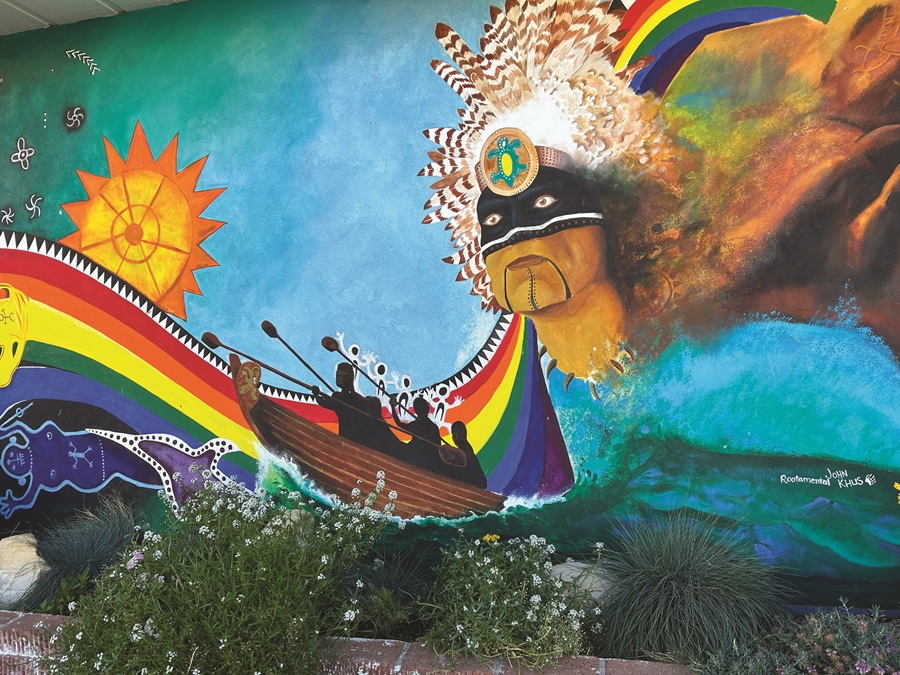
Mural “Tomol Rides Wishtoyo,” by John Khus.
Preserving Indigenous history through visual storytelling
—A mural by Chumash artist John Khus, celebrating the Chumash heritage adorns the front of the US Post Office in the Cambria’s East Village.
Chumash territory spanned 7000 square miles ranging from Malibu to Cambria and east to the edge of the San Joaquin Valley. Cambria is home to two Chumash village sacred sites that have been continuously occupied for 10,000 years. So, it made sense for the Chumash Council and Beautify Cambria to collaborate on a project to honor this rich history.
John Khus was selected to create a mural that celebrated the tribe’s history as the first people of San Luis Obispo County and the new Chumash Heritage Marine Sanctuary. The sanctuary is America’s 17th national marine sanctuary, and it’s one of the largest at 5543 square miles along 116 miles of coastline. Khus drew inspiration from Cuyama rock paintings, Canaliño rock paintings, and Ventureño rock paintings to create the mural, “Tomol Rides Wishtoyo.”
The mural tells the story of a Chumash elder watching over a tomol (canoe) full of human spirits traveling over a rainbow, known as Wishtoyo, to meet their ancestors. According to Khus, tomol crews knew the journey would be dangerous and “their connection to the spirit world would be very high during their time on the ocean.”
Every image in “Tomol Rides Wishtoyo” pays homage to the Chumash people and helps to educate visitors as well. So, what exactly does everything mean? The large rainbow is called a Wishtoyo. According to the Chumash, Earth Mother used the bridge for the Chumash people. It is also seen as a bridge to the sacred. The face of a Chumash leader is called a Wot. He would represent the voices of their people at councils and with the nation. The Wot worked closely with the people, medicine bearers, and the storytellers to make sure everything was in balance.
The tomol is the traditional Chumash canoe. The Chumash had many tomol fleets, and this enabled them to share, fish, and travel. Inspired by a Cuyama rock painting, Khus included a dancing spirit in abalone on the bow of the boat.
Behind the tomol crew is a drawing of four tomol paddlers. This is a partial translation of a rock painting from Cuyama. Just ahead of the tomol is the swordfish or ‘elye’wun. Khus combined elements from many different rock paintings to create the ‘elye’wun. The bill of the swordfish touches the navy-blue spirit Wot. She carries a staff to signify her position as a leader, and she also carries a child in her womb. The Spirit Wot was translated from a rock painting in Cuyama. The lighter blue spirit next to her is the moon spirit with a headdress of a crescent moon. She is also pregnant with a child. The moon spirit was translated from a Canaliño rock painting.
The green spirit next to the moon spirit is the spirit Lizard Wot. According to several Ventureño rock paintings, it is said that were it not for Lizard the hands of humans would be shaped like a coyote paw instead of the five fingers similar to those of Lizard.
The orange spirit is the Grandfather spirit who carries a staff of hawk’s feathers and healing medicine. The red spirit is the artist spirit who plays a flute which creates the sky. The music opens the Milky Way and the stars as the song floats from one horizon to the next.
The yellow Sun spirit sits on top of the other spirits. Her headdress represents the rays of the sun and the path of the sun throughout the seasons. Like the spirit Wot and Moon spirit, she carries a child in her womb. The mural also shows the sun, moon, and the Milky Way.
The mural is a colorful addition to the East Village of Cambria that serves to remind visitors of the Chumash tribe. The mural is located on the front of the post office at 4100 Bridge Street in Cambria.
—Karen Lycan











